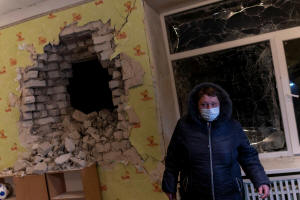Alarm as east Ukraine's most intense shelling for years enters second
day
 Send a link to a friend
Send a link to a friend
 [February 18, 2022]
By Anton Zverev and Pavel Polityuk [February 18, 2022]
By Anton Zverev and Pavel Polityuk
MOSCOW/KYIV (Reuters) -Ukrainian government
forces and pro-Russian rebels reported increased shelling in eastern
Ukraine for a second straight day on Friday, an escalation that
Washington and other Western allies say could form part of a Russian
pretext to invade.
A diplomatic source with years of direct experience of the conflict
described the shelling over the past two days as the most intense along
the frontline in eastern Ukraine since major combat there ended with a
2015 ceasefire.
Russia denies Western accusations it is planning an all-out invasion of
Ukraine, a country of over 40 million people, in what would potentially
be Europe's worst war in generations.
Moscow has said this week it is drawing down forces massed near Ukraine.
Western countries say they believe the opposite: more equipment and
personnel are arriving and making the sort of preparations normally seen
in the final days before an attack.
Financial markets are rattled by the prospect of a war that could
disrupt global energy supplies and wreck the recovery from the pandemic
crisis. They took some comfort from an announcement that U.S. Secretary
of State Antony Blinken would meet Russian Foreign Minister Sergei
Lavrov next week - provided Russia has not invaded first.

The marked escalation of shelling in eastern Ukraine, where government
troops have faced Moscow-backed rebels since 2014, has stoked global
alarm since Thursday. Both sides have said shelling stepped up
dramatically, although so far no deaths have been reported.
The diplomatic source said close to 600 explosions were recorded on
Friday morning, 100 more than on Thursday, some involving 152 mm and 122
mm artillery and large mortars. At least four rounds had been fired from
tanks.
"They are shooting - everyone and everything," said the source. "There's
been nothing like this since 2014-15."
The Kremlin called the situation in eastern Ukraine potentially very
dangerous.
In the most detailed U.S. warning yet of the likelihood of war, Blinken
told the U.N. Security Council Washington believed Russia was planning
an all-out assault. It could begin with a manufactured pretext, possibly
involving a faked attack and false accusations about the separatist
conflict, Blinken said.
WESTERN HYSTERIA?
U.S. President Joe Biden, rallying allies to maintain a unified stance,
will host a call on Friday with leaders of Britain, Canada, France,
Germany, Italy, Poland and Romania, plus the European Union and NATO.
The Kremlin has dismissed accusations it is planning an invasion as
Western hysteria. Moscow said on Friday that a tank unit and two
mechanised infantry units were heading back to bases in southern and
central Russia following exercises.
[to top of second column]
|

A local resident stands by a hole on the wall inside of a
kindergarten classroom, which, according to Ukraine's military
officials, was damaged by shelling, in Stanytsia Luhanska, in the
Luhansk region, Ukraine, February 17, 2022. REUTERS/Carlos Barria
 But Russia has also forcefully
pressed a set of security demands, including a promise Ukraine never
be admitted into NATO, which the West calls a non-starter.
On Thursday Russia delivered a strongly-worded
letter to the United States accusing it of ignoring Moscow's
security demands and threatening unspecified "military-technical
measures".
Russia announced President Vladimir Putin would personally supervise
exercises of its strategic nuclear missile forces on Saturday,
though it said these drills were no cause for alarm.
A quarrel over tit-for-tat diplomatic expulsions also heated up,
after Moscow ordered out the number two official at the U.S. embassy
in retaliation for what it said was the U.S. expulsion of an
unidentified Russian diplomat. Washington called the move
escalatory.
Ukraine itself has played down the likelihood that Russia will soon
invade, often putting it at odds with its Western friends. Kyiv
argues warnings of war play into Moscow's hands by sowing alarm and
hurting the fragile Ukrainian economy.
"Our intelligence sees every move that could pose a potential threat
to Ukraine. We estimate the probability of a large-scale escalation
as low," Defence Minister Oleksii Reznikov told parliament on
Friday.
BELARUS EXERCISES
Among the ambiguities surrounding the Kremlin's intentions are plans
for tens of thousands of troops staging exercises in Belarus, north
of Ukraine, due to end on Sunday. Moscow has said they would go back
to Russia at some point after the drills, but has not said when.
The Russian-backed leader of Belarus, Alexander Lukashenko, who
landed in Moscow on Friday to discuss the troop presence with Putin,
suggested the Russians could stay.

"The armed forces will stay as long as needed," Lukashenko was
quoted as saying by the state BelTa news agency.
Washington has made clear it will not send troops to defend Ukraine,
but it and its allies will respond with financial sanctions, a
threat Russia - already under santions since seizing Ukraine's
Crimea peninsula in 2014 - has brushed off.
The United States has however sent extra troops to reinforce NATO
countries bordering Ukraine. Defense Secretary Lloyd Austin
announced on Friday during a visit to Warsaw that Washington would
sell 250 Abrams tanks to Poland.
(Reporting by Reuters bureauxWriting by Peter GraffEditing by Gareth
Jones)
[© 2022 Thomson Reuters. All rights
reserved.] This material may not be published,
broadcast, rewritten or redistributed.
Thompson Reuters is solely responsible for this content. |